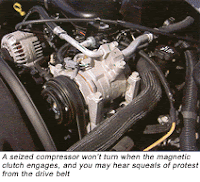 The compressor is the heart of the refrigeration circuit. It pumps and pressurizes the refrigerant to move it through the A/C system. Compressors work hard and run hot, up to several hundred degrees and several hundred pounds per square inch of internal pressure. They rely on only a few ounces of lubricant to keep their parts moving. If the lubricant is lost because of a leak, or the lubricant breaks down due to contamination, the compressor will not last. Sooner or later, the compressor will call it quits. The most common symptom of a compressor failure (besides no cooling) is a seized compressor. It will not turn when the magnetic clutch engages, and you may hear squeals of protest from the drive belt. Or, the belt may have already broken or been thrown off its pulleys.
The compressor is the heart of the refrigeration circuit. It pumps and pressurizes the refrigerant to move it through the A/C system. Compressors work hard and run hot, up to several hundred degrees and several hundred pounds per square inch of internal pressure. They rely on only a few ounces of lubricant to keep their parts moving. If the lubricant is lost because of a leak, or the lubricant breaks down due to contamination, the compressor will not last. Sooner or later, the compressor will call it quits. The most common symptom of a compressor failure (besides no cooling) is a seized compressor. It will not turn when the magnetic clutch engages, and you may hear squeals of protest from the drive belt. Or, the belt may have already broken or been thrown off its pulleys.Loss of lubrication is unquestionably the most common cause of compressor failure. This can happen when there is a refrigerant leak somewhere in the system that allows refrigerant and oil to escape. Typical leak points are hoses, hose and pipe connections (O-rings and flange gaskets), the evaporator, condenser or the compressor shaft seal. An electronic leak detector or dye should be used to find the leak so it can be repaired. A restriction inside the A/C system can also starve the compressor for oil. Oil circulates with the refrigerant, so if the orifice tube or expansion valve is blocked it may cause the compressor to run dry and seize.
Even if a compressor is still turning, it may have to be replaced if it�s leaking, making excessive noise or not working correctly. Some compressors are naturally noisier than others, but loud knocking noises can sometimes be caused by air in the system (the cure here is to vacuum purge the system to remove the unwanted air, then to recharge the system with refrigerant). Metallic noises and bearing noise are usually signals that the compressor is about to fail. A new compressor may be needed if the unit is leaking internally or not producing enough pressure due to bad reed valves, worn piston rings, or worn or scored cylinders, etc.). A worn compressor or one with internal problems will not be able to develop normal operating pressures with a full charge of refrigerant. This kind of problem can be diagnosed with an A/C gauge set. Poor cooling can also be caused by a lot of things other than a bad compressor, so do not replace the compressor until you have ruled out other possibilities such as a low refrigerant charge, too much oil in the system, air contamination, a clogged condenser, plugged orifice tube, inoperative electric cooling fan, etc.
Compressor operation can be affected by sensors in vehicles with automatic temperature control systems. Some have an A/C pressure transducer (usually mounted in the high side line) to monitor refrigerant pressure and shut off the compressor if pressure gets too high; a compressor temperature sensor to turn off the compressor if it gets too hot; and/or a compressor rpm sensor to monitor belt slippage. Mitsubishi, for example, uses a "belt lock controller" to disengage the compressor if the drive belt slips or the compressor seizes. On 1996 and newer Mercedes-Benz E-Class cars, the A/C control module will disengage the compressor if the refrigerant temperature and pressure sensors do not show a rise when the compressor is being driven.
